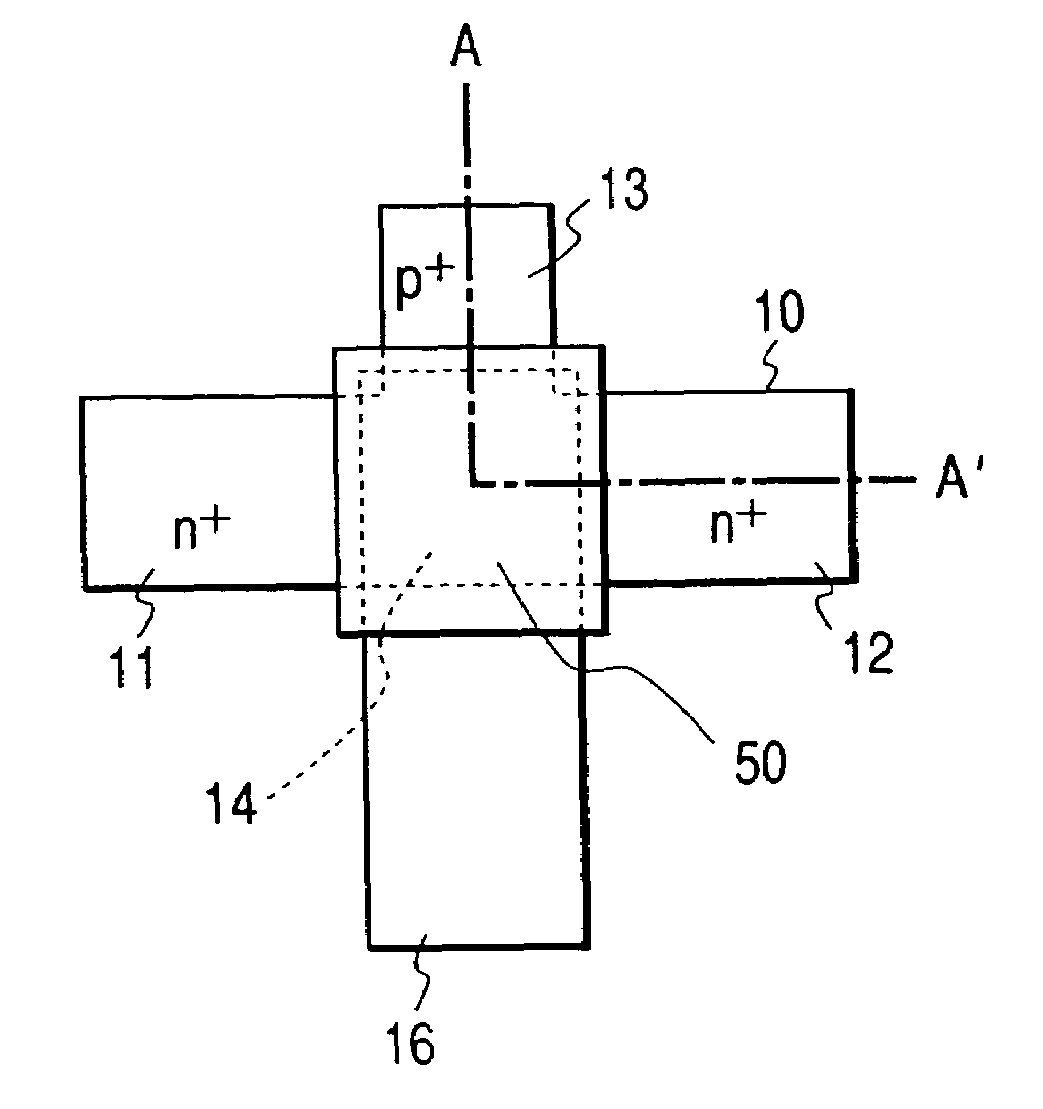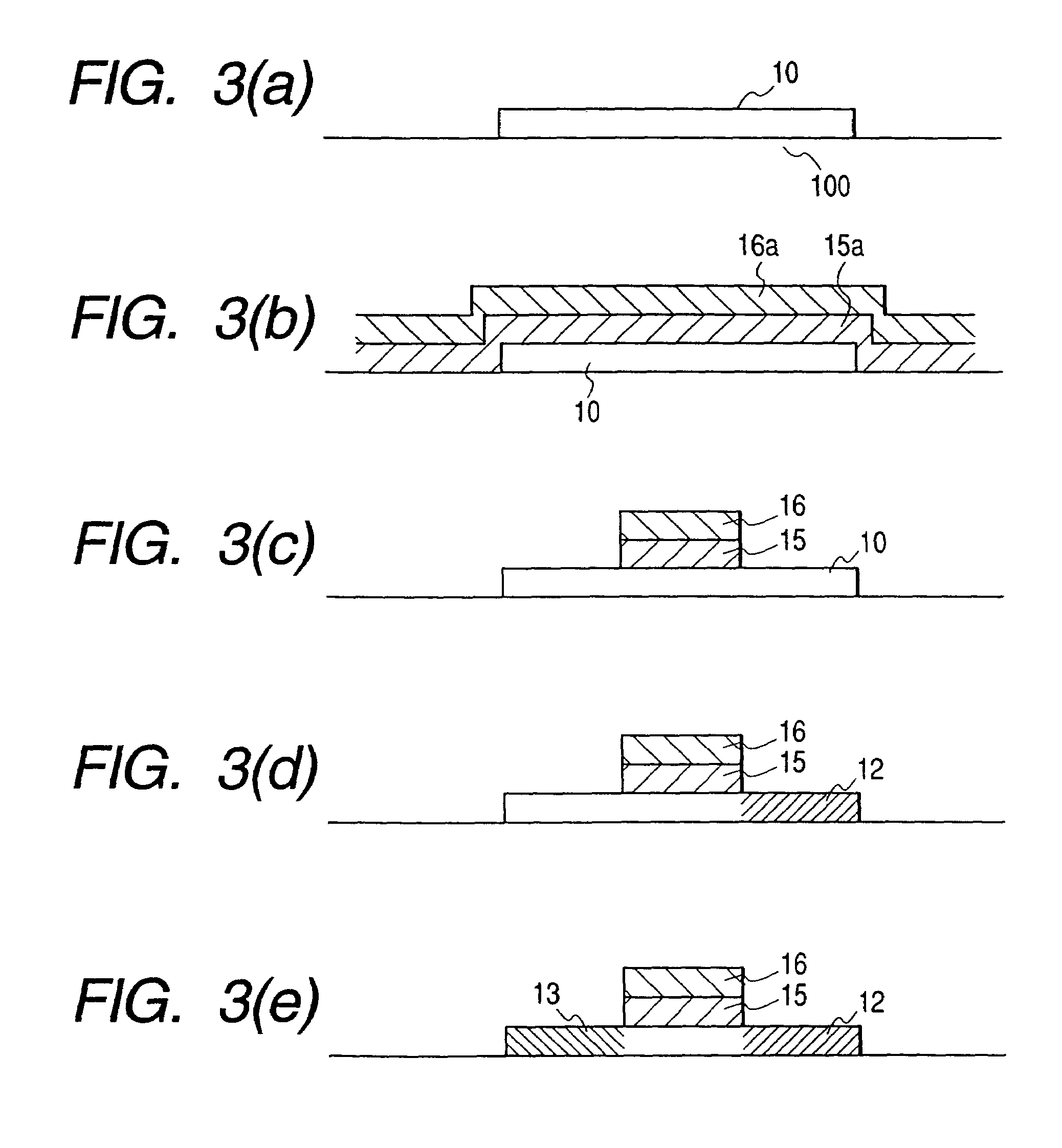Static RAM having a TFT with n-type source and drain regions and a p-type region in contact with only the intrinsic channel of the same
a static ram and source and drain technology, applied in non-linear optics, instruments, optics, etc., can solve the problems of not being able to reduce the size of the tft formed, driving up the cost of production, and high cost of quartz glass, so as to improve the display quality, and simplify the circuitry
- Summary
- Abstract
- Description
- Claims
- Application Information
AI Technical Summary
Benefits of technology
Problems solved by technology
Method used
Image
Examples
embodiment 1
[Embodiment 1]
[0043]FIG. 1 is a schematic plan view illustrating a TFT according to the present invention, and FIG. 2 is a schematic sectional view along a line A–A′ in FIG. 1. A substrate is a glass 100. A first layer is a thin polysilicon film 10. The thin polysilicon film 10 is constituted by a source 11 and a drain 12 which are n-type semiconductor regions, a p-type semiconductor region 13, and a channel region 14 just under a gate 16 which is an intrinsic semiconductor region. A second layer is a gate insulating film 15 which insulates the gate 16 and the thin polysilicon film 10 from each other. A third layer is the gate 16 having the same shape as the gate insulating film 15. Upon applying a positive voltage to the gate 16, an inverted layer in which the electrons are present in an excess amount is formed in the channel region 14 to form a channel, whereby the source 11 and the drain 12 are rendered conductive to each other to obtain a switching operation.
[0044]In the TFT str...
embodiment 2
[Embodiment 2]
[0048]FIG. 5 is a schematic plan view of a bottom gate type TFT according to the present invention, and FIG. 6 is a schematic sectional view along a line A–A′ in FIG. 5. A substrate is a glass 100. A first layer is a gate 16. A second layer is a gate insulating film 15 which insulates the gate 16 and a thin polysilicon film 10 from each other. A third layer is the thin polysilicon film 10. In the thin polysilicon film 10 are formed a source 11 and a drain 12 which are n-type semiconductor regions, a p-type semiconductor region 13, and a channel region 14 which is an intrinsic semiconductor region just over the gate electrode. A fourth layer is a channel protection film 50 for protecting the channel. Upon applying a positive voltage to the gate 16, an inverted layer in which the electrons are present in an excess amount is formed in the channel region 14 thereby to form a channel, whereby the source 11 and the drain 12 are rendered conductive relative to each other to o...
embodiment 3
[Embodiment 3]
[0049]FIG. 7 is a schematic sectional view of an SOI-MOSFET according to the present invention. FIG. 7 corresponds to FIG. 2 and FIG. 6, and in which are appearing a drain 12 and a p-type semiconductor region 13 in a semiconductor film 17. An insulating layer 19 is formed on a semiconductor substrate 18, and the semiconductor film 17 which is the first layer is formed on the insulating layer 19. The semiconductor film 17 is formed by, for example, single crystalline silicon or a single crystal of gallium-arsenic. The semiconductor film 17 is constituted by a source and a drain 12 which are n-type semiconductor regions, a p-type semiconductor region 13, and a channel region 14 which is an intrinsic semiconductor region just under the gate. A second layer is a gate insulating film 15 which insulates the gate 16 and the semiconductor film 10 from each other. A third layer is the gate 16 having the same shape as the gate insulating film 15. Upon applying a positive voltage...
PUM
| Property | Measurement | Unit |
|---|---|---|
| temperature | aaaaa | aaaaa |
| thickness | aaaaa | aaaaa |
| semiconductor | aaaaa | aaaaa |
Abstract
Description
Claims
Application Information
 Login to View More
Login to View More - R&D
- Intellectual Property
- Life Sciences
- Materials
- Tech Scout
- Unparalleled Data Quality
- Higher Quality Content
- 60% Fewer Hallucinations
Browse by: Latest US Patents, China's latest patents, Technical Efficacy Thesaurus, Application Domain, Technology Topic, Popular Technical Reports.
© 2025 PatSnap. All rights reserved.Legal|Privacy policy|Modern Slavery Act Transparency Statement|Sitemap|About US| Contact US: help@patsnap.com



